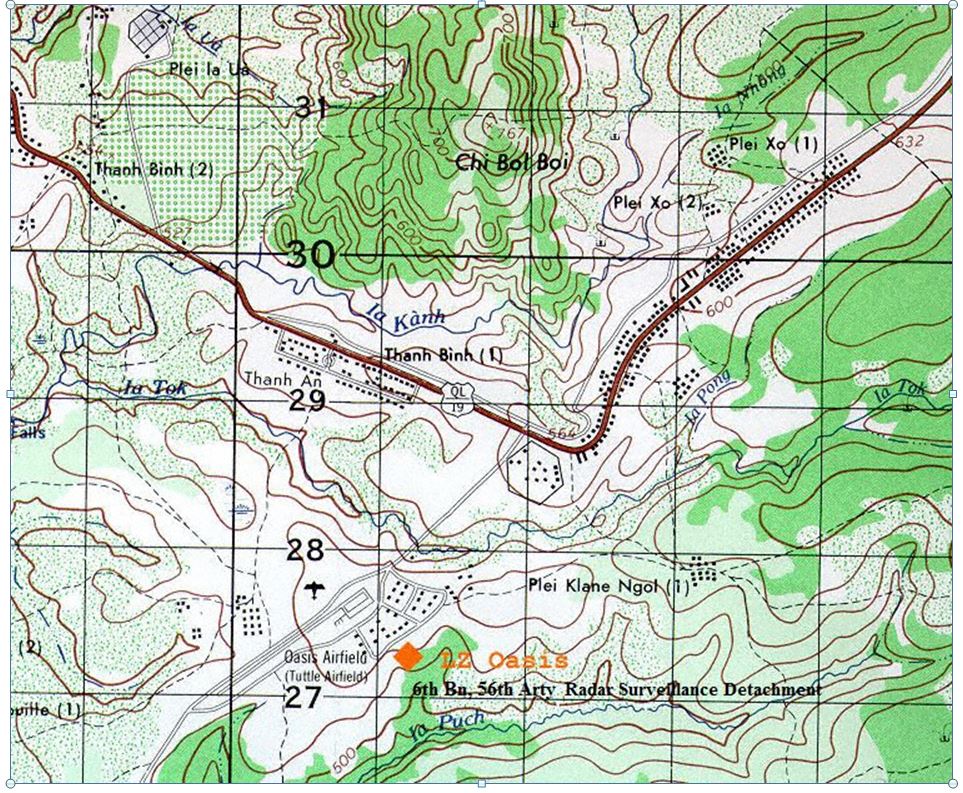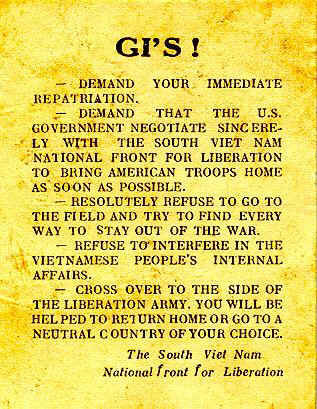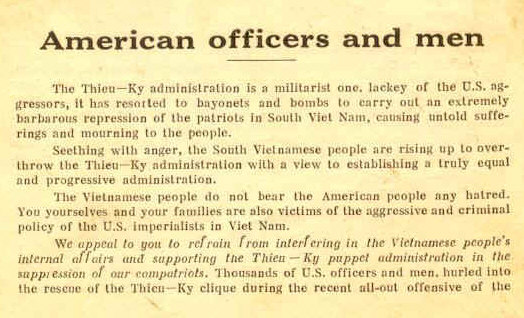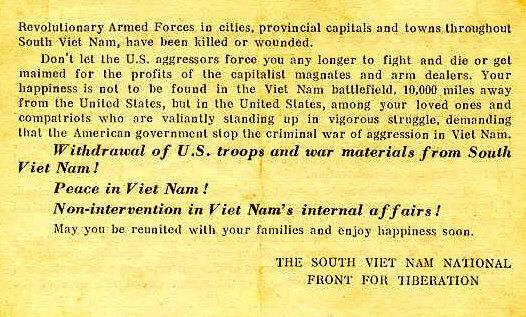
OPERATION
WESTERN PISTOL - LZ OASIS
WESTERN PISTOL -1FEB69
Western Pistol was a program to attempt identification of Soviet
helicopters operating in Western II CTZ. It increased concern that it could
represent a threat to the I FFORCEV operational area.
For approximately three weeks in March, an Army antiaircraft
searchlight was positioned in the area. Also, representatives from the MACV
Office of Scientific Advisors made three visits to record C Battery, 6thBattalion,
56th Artillery HAWK radar’s Doppler audio returns form track
detection, for comparison with cataloged recordings of foreign nation’s
helicopters.
On the night of 10 May 1969, LZ Oasis came under ground attack and
C Battery, 6th Battalion, 56thArtillery had two prime
radars destroyed by rockets and also sustained damage to other equipment.
On 27 June 1969, the Director of the TACC briefed COMUSMACV on the
project status and recommended the termination of the project. Approval was
granted by COMUSMACV.
THREAT
OF ENEMY HELICOPTERS: 2d LAAM Battalion, Chu Lai
Command Chronology Report, 2d Light Antiaircraft Missile Battalion,
Marine Air Control Group 18, First Marine Aircraft Wing, Located at Chu Lai,
Republic of Vietnam, 1 June 1968 to 30 June 1968 (SER:002A18468, 2 July 1968
(SECRET)
Part II. Significant highlights.
In the past month enemy helicopters have been operating in and
around the DMZ, above Doug Ha. The 1st Marine Air Wing has become deeply
concerned over the threat. The Air Force Combat Reporting Post (CRP) located at
Dong Ha has been unable to detect or control aircraft to intercept the
helicopters because their radars are unable to paint them at the altitudes day
are flying. The 1st Marine Aircraft Wing directed that 2d LAAM Bn conduct a
series of tests to determine if the Acquisition and tracking radars in the LAAM
To the above end, on 26 and 27 June 1968, the Battalion embarked on
a series of tests to determine the feasibility of utilizing the Pulse
Acquisition Radar, Continuous Wave Acquisition Radar and Continuous Wave
Illuminator Radar in conjunction with the Battery Control Central to detect and
acquire low flying helicopters and fighter interceptors. The position plots of
the helicopters and fighter interceptors were passed from the BCC over land
lines to the AAOC in geographic references coordinates (GEO REF), and were
placed on the Vertical Plotting Board. A qualified Air Controller used the
information from the plotting board to conduct the intercept. In the first test,
four A-4’s were utilized to attempt the intercept. The intercept information
was fed to the lead A-4, the remaining three A-4’s were two to three miles in
trail of the lead A-4. The idea was to close the lead A-4 with the target and on
command from the AAOC to drop illumination flares. The trail A-4’s were then
to close the eliminated helicopter, identify it and destroy it with rockets/20mm
guns. The results of this test pointed out that the HAWK Radars are capable of
detecting helicopters and fighter aircraft at low altitudes (1000 feet at 30
miles) and reporting the information with sufficient accuracy to complete an
airborne intercept. Six attempts were made to illuminate the helicopters, one
four occasions the helicopters reported that the flares were all around him at a
distance of about 500 yards. The in-trail A-4’s were unable to see the
helicopter although the helicopter pilot reported seeing the A-4’s.
A second test was conducted utilizing the same reporting and
plotting procedures to control A-6’s. The A-6 was vectored to the helicopter
and then utilized its internal radar to acquire and lock on the target. Three
out of four interceptors were successful wire acquisitions and lock ranges
varied between 7 and 19 miles.
The tests concluded that the principle of reporting plot
information from HAWK Radars to the AAOC is sufficiently accurate to conduct and
airborne intercept with information taken from a vertical plotting board. The
test further showed that the A4 dropping flares could not adequately illuminate
the target to identify and destroy it. The second position of the test pointed
out that the A-6 is capable of locking on and intercepting the helicopter with
intercept information provided from the AAOC.
On 24 June 1968 a reconnaissance of the Dong Ha area was conducted
by 2d LAAM Bn. A position collocated with the Air Force CRP was selected.
Battery B, 2d LAAM Bn stands ready to move out on order with a Low Altitude
Detection Unit, consisting of a Pulse Acq, CWAR, CWIR, BCC and necessary support
equipment and personnel to provide low altitude detection and to report plot
information to the CRP for the conduct of low altitude airborne intercepts.
In September 1968 the 6th Battalion, 56th Artillery
(HAWK) moved to the vicinity of Chu Lai, RVN, and conducted a relief of the 2d
LAAM Bn (USMC), establishes command and control facilities and assumed
responsibility for low and medium altitude air defense of the Chu Lai area.
Map
of the 6th Battalion, 56th Artillery HAWK Radar Surveillance Detachment

Unidentified Enemy Helicopters in Western II Corps
In
January 1968, reports of unidentified helicopter sightings in the Western II
Corps Tactical Zone (CTZ) increased concern that this could represent a threat
to I Field Force Vietnam (FFORCEV) operational area. This matter aroused
operational interest because the North Vietnamese Army (NVA) might be
transporting men and equipment by helicopter from Cambodia to strategic
locations in South Vietnam.
A program to attempt identification of
these tracks was proposed by 7th Air Force in January, approved
by Commander, United States Military Assistance Command, Vietnam (COMUSMACV) and
implemented on 1 February 1968. This operation was code name “Western
Pistol”. As you can see by the below listed aircraft and HAWK radar
equipment committed to this operation the threat was taken very seriously.
Operation
Western Pistol HAWK Radar Surveillance Detachment
During the reporting period ending 30
April 1969 elements of the 6th Battalion, 56th Artillery
continued Operation Western Pistol. Operation Western Pistol was a MACV directed
joint Army/Air Force project.
The following items of HAWK equipment
were used for this project:
a. Battery Control Central
b. Pulse Acquisition Radar
c. Continuous Wave Acquisition Radar
d. High Power Illuminator Radar
e. Range Only Radar
The concept of operation required that
an Air Force controller be station in the HAWK Battery Control Central. This
officer uses ground-to-air UHF radio and HAWK radar returns to vector Army and
Air Force aircraft to the vicinity of unknown tracks. Friendly air crews attempt
visual and /or photographic identification of unknown flying objects (UFO). The
following types of aircraft have been used:
a. AC 119- Shadow
b.
AC 47 – Spooky
c.
A1E – Spad
d. UH 1 – Shamrock
e. OV 1 – Mohawk
f.
UH 1G – Cobra
g.OH-6A –
Cayuse
Throughout this period a restricted
flight area west of LZ Oasis (From the Cambodian border at YA 8200, east to ZA
1000, north to ZA 1040, west to the Cambodian border at YA 6840) was in effect.
7th Air Force notice to airmen (NOTAM) 588 was distributed to
all friendly agencies operating in the prohibited area. This NOTAM outlined the
geographic limits of the prohibited flight zone and directed that all flights
below 800 feet and operating in that area from 1800 hours to 0600 hours
coordinate in advance with the Control and Reporting Post (CRP) at Pleiku.
The battalion commander 6th Battalion,
56th Artillery directed that a special operations center, a
combined manual AADCP and modified FDC, be organized for project Western Pistol.
The operations center is collocated with the HAWK radar detachment and has
communication links to Army ground surveillance and counter radar sites, Air
Force ground control radar, prime control and reporting post (CRP) radar at
Pkeiku and Fire Support Coordination Center, 3d Brigade, 4th Infantry
Division. All sighting are reported to the CRP at Pleiku for correlation and
possible identification.
Since the operation began the HAWK
radars operated from 1800 – 0600 hours daily. The daylight hours were devoted
to extensive equipment maintenance, which resulted in a minimal amount of HAWK
system downtime.
As of 30 April 1969, over 365
unidentified tracks were received since the operation began, the majority of
which were detected by the 6th Battalion, 56th Artillery
pulse acquisition radar. However, positive identification of the aircraft was
not established. A study of track data by the 7th Air Force and
battalion personnel indicated that the vast majority of tracks occurred between
2300 and 0200 hours. Tracks were consistently observed following stream beds,
valleys and appeared to terminate in areas displaying characteristics of natural
or prepared landing zones. Track characteristics showed speeds from a normal 60
knots to in excess of 150 knots. Doppler returns associated with the HAWK
tracking radar indicted aircraft of a rotary wing design.
On several occasions when being
directed to the vicinity of USO’s friendly air crews have observed airborne
red lights. However, the UFO’s consistently out maneuvered the friendly
aircraft resulting in the aircrew’s inability to make a positive
identification.
On 9 March 1969, representatives from
the 6th Battalion, 56th Artillery coordinated
with the Combined Intelligence Center, Vietnam (CICV). CICV provided
information on enemy ground activity within the Western II Corps area of
interest, in the form of a pattern analysis form 1 January to 31 March 1969.
Analysis of all available CICV intelligence for possible correlation with UFO
track data indicates that UFO’s appeared to originate in known enemy base
camps in Cambodia and on numerous occasions, terminated in the vicinity of known
or suspected enemy concentrations and supply points in the 4th Infantry
Division area of operation.
In early April 1969, a free fire zone
for ground targets was established by the 3rd Brigade, 4th Infantry
Division. The zone was located in an area of high density UFO track activity and
probable landing zones. Within this area, any target on the ground to include
UFO tracks appearing to land may be fired upon.
6th BATTALION, 56th ARTILLERY ADJUSTED FIELD ARTILLERY GUNS
Collocated with the detachment at LZ
Oasis was an 8-inch howitzer battery. These weapons would immediately
respond to fire missions initiated by the HAWK detachment commander. It should
be noted that field artillery adjustment of fire was effected through the use of
the Tactical Control Consol in the HAWK Battery Control Central (BCC) by
observing PAR returns of bursting projections. In the Western pistol Operation
Center, all track data was converted to polar coordinates by detachment
personnel and was passed to the battery FDC in an extremely rapid manner.
6th BATTALION,
56th ARTILLERY COMMAND OBSERVED NVA HELICOPTER
On the night of 10 April 1969, while
flying in a friendly intercept aircraft the battalion commander, 6th Battalion,
56th Artillery and several members of the aircrew observed a UFO
with the outline characteristics of a Soviet Mi-6 Hook helicopter. Again, on 20
April 1969, another aircrew sighting was made and the UFO observed had the
characteristics of a Mi-4 Hound, Soviet helicopter.
LZ
Oasis Mother's Day 10 May 1969
On Mother's Day 10 May 1969 12 km southwest of Pleiku City the 4th Infantry
Division Headquarters at LZ Oasis received indirect fire from small arms fire
from an unknown size enemy force resulting in friendly killed, wounded
and missing with enemy killed. The Hawk site had two prime radars
destroyed by rockets. One Hawk radar was destroyed by a direct hit.
Sgt
CLIFFORD WIPPEL, HEROISM AT LZ OASIS
It took almost four years for a former Ellensburg soldier’s heroism to be
recognized, but Clifford Wippel, 28, has finally received the Army’s
Commendation Medal with “V” Device for his conduct under fire in Vietnam on
May 11, 1969.
He learned of the award only
recently, according to his father, Mose Wippel of Ellensburg.
The award recognized Wippel’s
heroism in connection with military operations against a hostile force in the
Republic of Vietnam. Sergeant Wippel distinguished himself by valorous actions
on May 11, 1969 while serving as Communication Sergeant with C Battery, 6th Battalion,
56th Artillery. On that date, Landing Zone Oasis came under an
intense mortar, rocket and ground attack from a battalion size enemy force.
Realizing the seriousness of the situation, Sergeant Wippel, with complete
disregard for his personal safety, braved the hostile fire as he moved to each
bunker position along the perimeter to insure that communications links were
operating property. He then established communications with the command bunker,
and took part in holding of the instrumental in the successful defense of the
landing zone. Sergeant Wippel’s personal heroism and devotion to duty are in
keeping with the highest traditions of military service, and reflect great
credit upon himself great credit upon himself, the Americal Division, and the
United States Army. Ellensburg Daily Record April 27, 1973
The result of the action 10 May 1969 at LZ Oasis:
US LOSSES:
Personnel:
10 killed in action (KIA), 1 died of wounds (DOW), 16 wounded in action (WIA), 3
missing in action (MIA)
Equipment:
1 M151A, 1 50 Caliber Machine Gun, 1 Radio Beacon, 1 Water Truck, 1 Fire Truck,
3 5/Ton Trucks, 1 Pulse Acquisition Radar (C/6/56th Arty
HAWK),
1 Continual Wave Acquisition Radar (C/6/56th Arty
HAWK),
1 High power illumination radar (C/6/56th Arty
HAWK),
1 Battery control (C/6/56th Arty (HAWK), 1 Conex,
3 M151A1, 3 M37, 1 V-100,
2 GP Medium Tents, heavily damaged, 5 GP Medium Tents, lightly damaged
ENEMY LOSSES:
Personnel:
103 KIA
Equipment:
5 Packs, 1 SKS, 1 Field phone, 4 AK-47 magazines, 1 Radio case, 3 B-41 Rockets,
41 Increment charges, 3 Pith helmets, 8 Blocks of explosives, 3 US type signal
pistols,
4 Unknown type booster charges, 3 Pounds quinine, 2 B-41 Rocket launchers,
1 B-40 Rocket launcher, 3 AK-47's, 6 B-41 Rounds, 1 9mm Pistol, 14 Satchel
charges,
1 60mm Round, 5 Pull charges, 3 RKG-3, 2 US watches, 6 M-79 Rounds,
1 NVA Wire spool w/100 feet wire, 15 50 Caliber ammunition cans full of rice,
27 Pair undershirts, 38 Pair pants, 49 Shirts, 21 NVA Mess kits, 650 Rounds
AK-47 ammo
18 B-40 Rounds, 46 ChiCom grenades, 1 MS Grenade, 40 Stick grenades, 8 Fuze
assemblies
85 X-shaped charges, 30 Pounds rice, 82 Small C-4 explosives charges, 2 Picks,
18 Shovels,
2 Pounds black powder, 67 Blasting caps, 4 Canteens
Propaganda
Leaflets
Leaflets which picked them up off the ground the morning after the
1969 Mother’s Day battle at LZ Oasis, Central Highlands, Republic of Vietnam.
 |
 |
 |